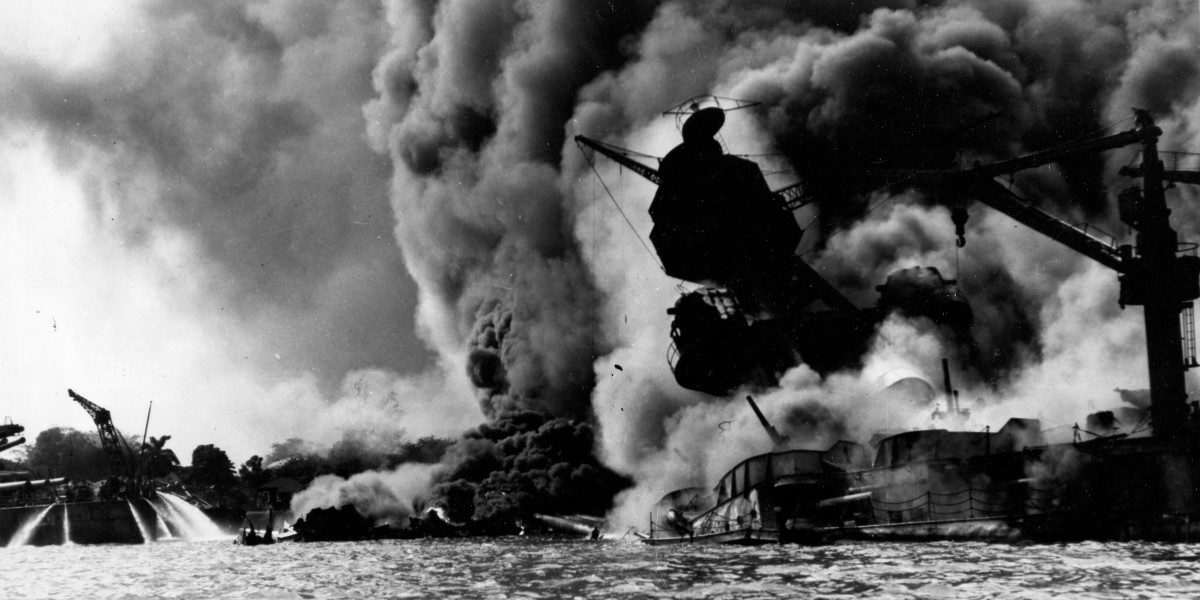December 7th, 2021 marks the 80th anniversary of the attack on Pearl Harbor, which thrust America into the Second World War. Take a look at ten interesting details you may not know about the morning of December 7th, 1941.
1. Americans fired the first shot.

At 6:37 a.m. on the morning of December 7th, 1941, the Wickes-class destroyer USS Ward attacked and sank a Ko-hyoteki-class midget submarine near the entrance to the harbor, officially making it not only the first shot fired on that day, but the first American shots in the War in the Pacific. The sub’s periscope was spotted above the water by the minesweeper Condor, which alerted the crew of the Ward, who opened fire on the intruder.
2. The whole attack took only two hours.

Ultimately, 2,403 Americans died in the attack and 1,178 were wounded. A total of 18 ships were lost or damaged, including the USS Arizona, which still leaks oil from beneath the war memorial in the harbor. All this damage was inflicted in just two short hours.
3. Aboard the USS Arizona alone, 23 sets of brothers perished.

37 pairs or trios of brothers were assigned to the USS Arizona. Of those, 23 sets were killed, constituting 62 men. As a result, the US Navy actually attempted to discourage the practice of family members serving aboard the same vessels, but no official regulations were ever put in place.
4. The USS Nevada tried to make a run for it.

Already unmoored before the attack began, the Nevada left its berth in Battleship Row and tried to make it to the harbor entrance, fighting the entire time. After being repeatedly attacked on its way—she was hit by multiple bombs and torpedoes—the Nevada beached itself on Hospital Point (see above). Before striking the shore, gunners aboard the Nevada managed to shoot down three planes, including the Nakajima B5N that damaged her with the first torpedo.
5. Five Americans managed to get airborne.

A total of five Army Air Corps pilots managed to take flight and go after Japanese planes. No one knows for certain how many planes those pilots shot down, but pilots Ken Taylor and George Welch were credited with at least seven of the 29 Japanese aircraft brought down by American guns. Taylor and Welch heard gunfire early in the morning and phoned and told the base to arm and fuel their P-40s. Welch was recommended for the Medal of Honor for his heroism, but it was denied him because his commanding officer said he had taken off without orders.
6. The Japanese really wanted to take out our aircraft carriers.

But they weren’t in port at the time. The Lexington, Enterprise and Saratoga were all out to sea on December 7th. The Imperial Japanese Navy actually knew this at the time, but reasoned their plan to destroy the maximum number of battleships would constitute a decisive enough victory.
7. Americans captured a POW.

After the second wave’s guns had gone dry and the attack was finally over, 64 Japanese attackers were dead. But did you know that the Americans captured the very first Japanese POW of World War II on that day? Kazuo Sakamaki, a submariner, was chosen to attack ships in a midget-class sub. During the mission, his sub was disabled and he tried to blow it up with an explosive charge, which failed to go off. When he dove down to investigate why it didn’t detonate, he passed out. Unconscious, Sakamaki floated to the surface and washed up on shore where he was discovered and captured. He spent the whole war in a POW camp. After the war, he worked for Toyota and died in 1999.
8. The “Day of Infamy” speech was only seven minutes long.

President Franklin D. Roosevelt’s wording was carefully chosen to emphasize the atrocity of the attack and the victimhood of the United States, placing the country as the subject of the opening sentence—The passive phrase, “the United States was … attacked” as opposed to the more active, “Japan attacked the United States.” Roosevelt’s speech was designed as a more specific declaration of war, and a departure from the more abstract appeal that President Woodrow Wilson used in his speech to Congress in 1917 when the US entered World War I.
9. Canada technically declared war on Japan before the United States did.

Japan’s invasion of Hong Kong began the morning of December 8th, 1941. Hawaii’s timezone is 18 hours behind, meaning that while British, Indian, and Canadian forces defended against the Japanese forces, war between Canada and Japan was already underway before the first bombs fell on Pearl Harbor. As a result of the Hong Kong invasion as well as the surprise assault on Canada’s North American ally, Prime Minister Mackenzie King (above) declared that a state of war existed with Japan, which preceded President Roosevelt’s address by mere hours.
10. Many Japanese tourists pay their respects at the Pearl Harbor memorial.

Now one of America’s strongest allies, Japan is the largest source of international tourists to the state of Hawaii. Japanese citizens of all ages—including veterans of the war—go on guided tours to the memorial like the one shown above, to learn about the event which launched the bloody conflict between Japan and the United States, and to the pay respects to the fallen.

